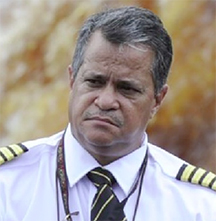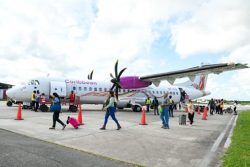-cites plethora of weaknesses in aviation regime
The decision by the Guyana Civil Aviation Authority to effect a temporary suspension of interior shuttles following three recent aircraft accidents, the first and the last of which took the lives of the pilots, has elicited a strong response from one of the country’s most experienced pilots who is advocating that an improved safety regime in the domestic aviation sector depends largely on upgrading facilities and raising standards.
Stabroek Business has seen a letter written to GCAA Director Lt. Colonel Egbert Field by Roraima Airways Chief Executive Officer, Captain Gerry Gouveia in which he repeated an earlier remark that the suspension of interior shuttles was a “knee jerk” response and went on to direct a series of withering criticisms at the local aviation regime.
Yesterday, the GCAA announced that Trans Guyana Airways has been given approval to resume shuttle flights. Roraima and other operators are still awaiting clearance.

In his letter to Field, Gouveia blames “inadequate institutional state systems to support a growing aviation sector” for the fact that “qualified pilots flying perfectly safe planes must often times rely on local knowledge…and extraordinary human skills to complete flights daily into our hinterland.” In his letter, Gouveia, with more than forty years experience flying in the interior says that the conditions to which pilots are exposed include a local aviation landscape that is “plagued by high mountains, high trees, short runways with poor surface conditions, no air traffic control support outside seventy five miles from the Cheddi Jagan International Airport, Timehri and lack of adequate and relevant weather information in an environment which is generally hostile and unforgiving.
In his letter, Gouveia says that while he has no objection in principle, with the GCAA’s request that operators in the sector submit Standard Operating Procedures (SOPs) for shuttle operations he believes that the suspension order is a reaction to “what I believe is a much more substantial series of issues that need a more comprehensive and detailed review and action. In his letter the Roraima Airways boss also alludes to what he says will now be the “undue and unnecessary hardships” which the people of the hinterland will be facing “while manuals are written to outline what is generally already being done on a daily base by pilots as they shuttle food and supplies to remote areas on the mountains.”
Structural
In his letter Gouveia lists a range of “structural and operational deficiencies” faced by pilots flying in the interior including a lack of accurate and relevant weather information, a lack of air traffic control to separate aircraft beyond the 75 miles radius of CJIA, a lack of security and management systems on hinterland runways, lack of search and rescue and management systems on hinterland runways, poor runway surface conditions, lack of search and rescue and non-existent navigational aids “outside the seventy five-mile radius. Gouveia also says in his letter that “inadequate lessons” have been learnt from past accident investigations.
Three interior aircraft mishaps in a matter of weeks have brought the sector into sharp focus and raised safety-related concerns. On July 25 a Britten-Norman Islander owned operated by Roraima Airways crashed on landing at Eteringbang. The pilot, Captain Colin Martin, who was shuttling Cargo between two interior locations was killed. On Tuesday August 8, a single engine Cessna aircraft operated by Wings Aviation crashed shortly after taking off from the Eteringbang airstrip. The pilot, Captain Dominique Waddell who was shuttling cargo from Eteringbang to Ekereku escaped with minor injuries. On Sunday August 27, Air Services pilot Imran Khan died after the Cessna aircraft that he was flying crashed three miles west of Mahdia in Region Eight.
Meanwhile, in addressing what he described as the “current operational status” of the interior aviation services Gouveia alluded to the fact that flights are sometimes dispatched with insufficient or inadequate knowledge of the en route weather, , the winds aloft , and more specifically, the details of weather systems at the destination and forecast weather at the alternate runways in circumstances where pilots continue to report “highly unusual and unexpected weather conditions” daily; additionally, according to Gouveia, pilots are required to fly unassisted through vast expanses of airspace beyond the seventy-five mile radius of CJIA. “Pilots must therefore take on the added responsibilities of multi-tasking as an air traffic controller, and is essentially solely responsible for the safety of him/herself and passengers beyond the 75-mile radius.”
In his letter Gouveia also expressed concern over the fact that “pilots are landing on state owned runways that have no airport security systems and no operational management control systems, exposing them to the hazards of unexpected runway incursions by vehicles, individuals and animals.”
And even more specifically, not knowing with certainty whether the runways are cleared of objects and obstacles, which could cause severe damage to the aircraft on takeoff or landing.
Stress
The stress on the minds of the pilots are amplified by the thoughts and knowledge of the clear and present danger they face as a result of the lack of an established national
Search and Rescue Systems, – and more particular, the lack of the ability of the state and regulatory authorities to effectively conduct a successful and timely rescue operation to save lives given the lack of an adequately equipped helicopter . There is a total lack of Navigation Aids outside the 75 mile radius around CJIA , leaving the pilots to their own devices to navigate across our vast country.
While our pilots are highly and suitably trained, their safety are threatened by the lack of institutional support, and as such every flight they take into the interior of Guyana can be deemed high risk… even more specifically, not knowing with certainty whether the runways are cleared of objects and obstacles, which could cause severe damage to the aircraft on takeoff or landing.” He said that the stress on the minds of pilots is “amplified by the thought of the clear and present danger they face as a result of the lack of an established national Search and Rescue Systems”
In his letter Gouveia lists a number of what he describes as “specific and actionable solutions” including the implementation of the use of high-end MAP GPS in each aircraft; make it mandatory that pilots are trained and competent to operate GPS systems; mandate that pilots are competent to determine the safety accuracy checks of the GPS prior to each flight utilizing the ground-based navigational system available at the CJIA ; Establish flight corridors for every route into the hinterland runways using agreed on GPS waypoints; establish procedures to assist pilots in maintaining stabilized flight and stabilized approaches to all runways; mandate that every aircraft be equipped with the ADBS Systems tracking system; ensure that the state ADBS system is fast tracked to completion and is always operational and functioning ; mandate that spot trackers be installed on every aircraft operating in Guyana; require each airline to possess the ability to track their aircraft moment by moment; make it mandatory that every runway operate with a management system for security and operational readiness; ensure that a reliable and accurate national weather reporting system be put in place, and deployed across the country; ensure that air traffic control services are deployed at specific geographic locations beyond the 75 mile radius of CJIA such as Kaieteur Falls , Port Kaituma and Lethem to mitigate against mid – air collisions; move immediately to create a national rescue capability by acquiring an appropriate/suitable helicopter to execute timely and safe extractions from the jungle if the need arises; organize and schedule national aviation safety seminars bi-annually for all local aviators and revise the bi-annual flight checks for pilots to include a route check operating in compliance with the new GPS procedures.






